

Table of contents
- viral diseases
- Cucumber moasic virus
- Cucumber green mottle mosaic virus
- Cucumber leaf spot virus
- Other viral diseases
- bacteria
- Angular leaf spot (Pseudomonas syringae pv. lachrymans)
- fungal diseases
- Powdery mildew (Spaerotheca fuliginea and Erysphie cichoracearum)
- Downy mildew (Pseudoperonospora cubensis)
- Gumstick disease (Didymella bryoniae)
- Gray mold (Botrytis cinerea)
- wilting diseases
- Fusarium wilt or cucumber wilt (Fusarium oxysporum)
- Stem round rot (Fusarium solani)
- Black root rot (Phomopsis sclerotioides)
- Sclerotinia wilt or Sclerotinia stem rot (Sclerotinia sclerotiorum)
- Verticillium wilt (Verticillium albo-atrum and Verticillum dahliae)
- pests
Cucumbers from your own garden or greenhouse are a pleasant refreshment in summer. However, the joy is spoiled when the plants, be it outdoors or in the greenhouse, become ill. That's why you should check them regularly for cucumber diseases, because that way there's hope that the diseases won't spread.
viral diseases
Viral diseases of cucumber plants are now a major problem. More than 25 viruses are currently known to cause diseases in cucurbits (Cucurbitaceae). Effective treatment of the plants is not possible with most viruses, so you should remove and discard diseased cucumber plants immediately.
Cucumber moasic virus
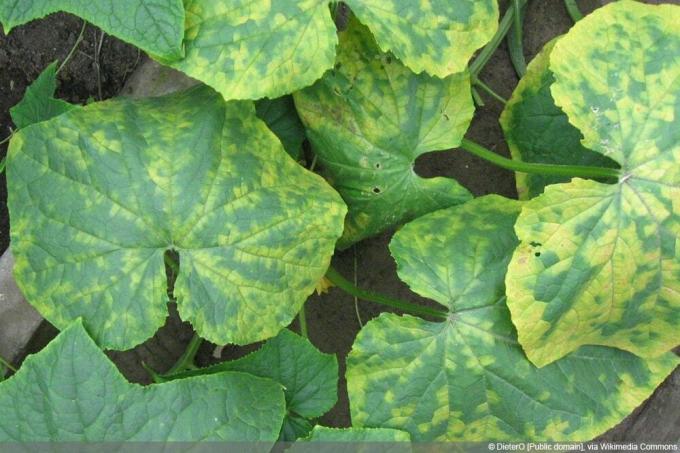
The cucumber mosaic virus is transmitted by aphids. However, transmission can also take place through cutting tools if these have not been disinfected before use.
damage picture
Once the virus has infected the plant, buckling, leaf deformation and appearances reminiscent of a mosaic are formed. If the temperatures are above 24 degrees Celsius, the (young) leaves turn yellow or light green like a mosaic. At temperatures below 20 degrees, the affected plant begins to wither. Warts and spots may appear on the cucumbers themselves.
countermeasures
To protect the plants from the cucumber mosaic virus, you should make sure that no aphids nest. Once an infestation has set in, the aphids must be removed immediately.
Tip:
There are now many cucumber varieties that are extremely robust against the cucumber mosaic virus. It is best to choose one of these varieties when purchasing.
Cucumber green mottle mosaic virus
The green piebald mosaic virus is transmitted to greenhouse cucumbers via the plant sap. This can be via soil, seed or non-disinfected cutting tools. Since the virus can enter the plant through any open wounds, chewing insects are also among the causes of the disease, even if they do not transmit it.
damage picture
- This disease occurs in greenhouse crops. Symptoms are:
- light to dark green spots on the leaves
- bulging, dark green sections on leaf blade
- Cucumber fruits: discoloration and necrosis inside
countermeasures
A treatment for the disease is not yet known. If you notice any abnormalities, the diseased plant must be isolated immediately and parts of the plant that have been cut off must be burned immediately. Preventive measures are:
- only virus-free seed or use substrate
- only use disinfected cutting tools
- Control chewing insects with organic means
Cucumber leaf spot virus
Cucumber leaf spot virus threatens greenhouse crops.
damage picture
light to yellow-green spots with a brown, necrotic spot in the middle on the leaves
- initially only on young leaves
- Blisters on the surrounding green leaf tissue
- There are no symptoms on the cucumber fruits.
countermeasures
So far, no treatments for the disease are known. Therefore, you should immediately discard the diseased plant.
Other viral diseases
Other viruses that cause cucumber diseases include:
- cucumber yellowing virus(beet pseudo yellow virus)
- cucumber necrosis virus(tobacco necrosis virus)
- Arbai Mosaic Virus(arabis mosaic virus)
- Melon Necrosis Virus(melon necrotic spot virus)
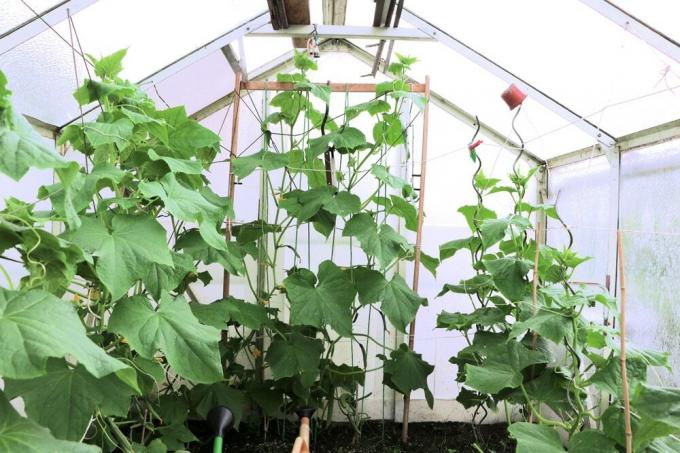
Since there is currently no treatment for cucumber diseases, the affected plants must be removed and destroyed immediately. To prevent the virus from spreading further, you should thoroughly clean all containers, equipment and hands.
damage picture
You can identify signs of these cucumber diseases by the following symptoms on the leaves:
- mosaic discoloration
- yellowing
- twists
bacteria
Various bacteria can also make a cucumber plant sick.
Angular leaf spot (Pseudomonas syringae pv. lachrymans)
Angular leaf spot disease occurs primarily in outdoor cucumbers, but can also occur in greenhouse cucumbers. The cause is the bacterium Pseudomonas lachrymans, which overwinters on plant debris, in seeds and in the soil. It is usually transmitted from the ground to the outdoor cucumbers by splashing water (rain or irrigation water). If an infestation occurs, the diseased plants must be disposed of immediately.
damage picture
Pseudomonas lachrymans infests leaves, stems and later cucumbers. Signs and symptoms of the disease are:
- straw yellow to light brown angular spots on the leaves
- Leaves gradually dry out
- Leaves split open
- Pieces of tissue tear out
- Formation of irregularly shaped holes in the leaves
- small, circular spots on the cucumbers
- diseased areas open and turn white
countermeasures
Only preventive measures help against angular leaf spot disease. This includes using only disease-free seeds. In addition, no more pumpkin plants should be planted in the appropriate place for two to three years after infestation. After that, the soil should be free of the bacterium again. In greenhouses, high humidity (80 to 90 percent) helps against the bacterium.
Tip:
There are now cucumber varieties that are resistant to the bacterium.
fungal diseases
Fungal infections in cucumbers are just as stubborn as cucumber diseases caused by viruses or bacteria. Successful control is only possible in the rarest of cases.
Powdery mildew (Spaerotheca fuliginea and Erysphie cichoracearum)

Powdery mildew is caused by fungi from the Erysiphaceae family. Outdoors, the cucumbers are attacked primarily by Erysiphe cichiracearum, while in the greenhouse it is often Spaerotheca fulignea. Powdery mildew fungi develop especially well in sunny and dry weather. Their habitat is the leaves of cucumbers.
damage picture
At the beginning of infection, white flour-like spots form on the leaves. As the disease progresses, the entire leaf is covered with a slightly gray coating, which causes the leaf to die prematurely.
countermeasures
Only removing the plant helps against powdery mildew so that the fungus cannot spread further. The only way to prevent the fungus is to buy mildew-resistant varieties.
Downy mildew (Pseudoperonospora cubensis)
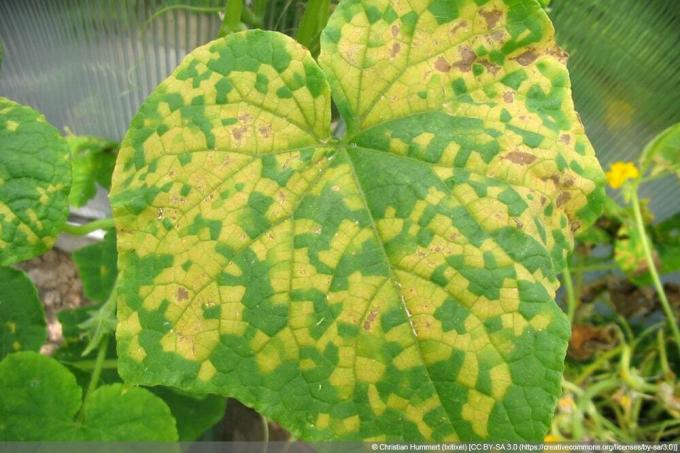
The downy mildew of cucumbers mainly affects pickling and salad cucumbers outdoors and in greenhouses.
damage picture
- initially light green to yellow-brown angular spots on the upper side of the leaf
- grey-violet coating on the underside of the leaves
- in the course of the disease: leaves turn yellow, then brown and die
countermeasures
As with powdery mildew, there is no antidote to the wrong thing. However, there are cucumber varieties that are less susceptible to downy mildew. In the greenhouse, dry cultivation can help against the fungus. In addition, you should always ventilate the greenhouse well, even in cooler summer weather.
Gumstick disease (Didymella bryoniae)
The fungus Didymella bryoniae is the cause of gumstem disease. The infection occurs primarily in the greenhouse culture of cucumbers. The disease is transmitted by spores that adhere to seeds, clothing, cutting tools and parts of plants.
damage picture
Affected plant parts are leaves, stems, fruits and in rare cases the roots. Symptoms on the leaves are:
- initially brown to light beige spots on the leaf edges
- spread toward the middle of the leaf
- necrosis
- dull and darker green tissue between diseased and healthy areas
- small, black dots on the spots (spore bodies)
The symptoms on the stems are similar:
- appear gray from a distance (spore bodies)
- acquire a rubbery consistency as the disease progresses
- yellow drops on the stems
Cucumbers are infested through the point at which the flowers begin. As the disease progresses, the fruit tip contracts. Spore bodies later form there, which makes the tip look black. When you cut open you will see a light to dark brown fruit core.
countermeasures
As soon as you spot signs of the disease, you should remove the affected plants. Reduced humidity helps against flying spores. Fungal growth is slowed down by a rapid rise in temperature in the morning.
Gray mold (Botrytis cinerea)

Botrytis cinerea affects leaves, stems and fruit buds.
damage picture
All affected parts of the plant are covered with a thick, greyish spore coating.
countermeasures
Since the fungal spores survive in the soil, you should only water the plants close to the ground and avoid splashing water. Good air circulation in the greenhouse prevents gray mold infestation.
wilting diseases
Various wilt diseases are also dangerous for pitted plants.
Fusarium wilt or cucumber wilt (Fusarium oxysporum)

Victor M Vicente Selvas, Tomaquera amb Fusarium HV, edited by Hausgarten, CC BY-SA 3.0.
Fusarium oxysporum is a soil fungus that enters plants from the substrate and clogs their pathways in the stems.
damage picture
Since the plant can no longer be supplied with nutrients due to the blocked pathways, it wilts and subsequently dies. You can recognize the fungus itself by a pink fluff at the base of the stem.
Stem round rot (Fusarium solani)

This fungal infection mainly occurs in greenhouses.
damage picture
A slightly white to whitish-green mycelium appears at the base of the stem. If the plant is infected, it wilts almost suddenly and dies after a short time. Other characteristics are rotting and rotting at the base of the stem.
Black root rot (Phomopsis sclerotioides)
Black root rot yellows the lower leaves of cucumber plants, which die off as the disease progresses. There are signs of decay at the base of the stem. The roots turn black and rot.
Sclerotinia wilt or Sclerotinia stem rot (Sclerotinia sclerotiorum)

You can recognize this fungal disease by a white, cotton-like mycelium at the base of the stem. Black fruiting bodies with a diameter of up to one centimeter develop in this. If the fungus spreads to the cucumber fruits, they will also be covered by the mycelium.
Verticillium wilt (Verticillium albo-atrum and Verticillum dahliae)
This wilt disease is particularly common when soil and air temperatures are low. The first signs are sagging leaves at the bottom of the plants. As the disease progresses, they turn brown. Inside the stalk, there is a gray or brown discoloration of the pathways.
countermeasures
In the event of a wilt disease, the affected plant must be removed and destroyed immediately. In addition, the soil should be replaced to a depth of 25 to 30 centimeters. If this is not possible, then as many roots as possible should be removed from the ground.
pests

In addition to diseases caused by viruses, fungi or bacteria, various pests can also nest in the cucumber plants. This includes:
- cucumber aphids
- miner fly
- spider mites
- thrips
- white bow tie
- bugs
If you find an infestation, then you should fight the pests with organic means and isolate the infested plant if possible.
 Home editorial office
Home editorial office
Learn more about plant diseases
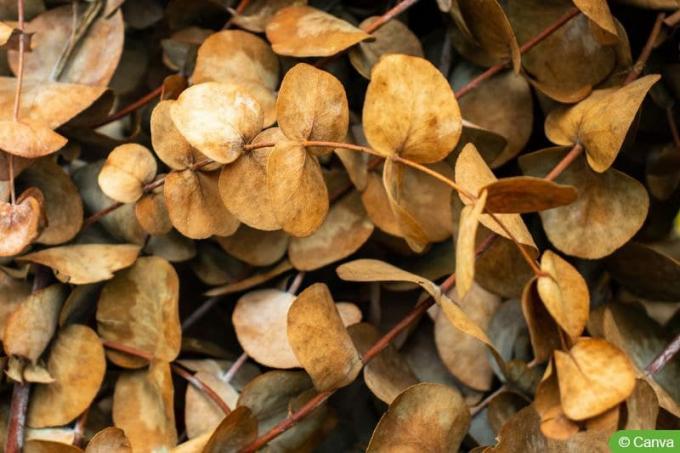
Eucalyptus gets brown/yellow leaves
The eucalyptus is becoming more and more of a trend plant. With its blue-green leaves, the eucalyptus sets beautiful accents. Occasionally, however, foliage discoloration may occur. Everything about the causes and remedial measures below.

Small white dots on leaves: what to do?
When white dots appear on the leaves of crops, take a closer look as they can indicate problems. This text explains what causes can be responsible for this and what you can do about the stains.
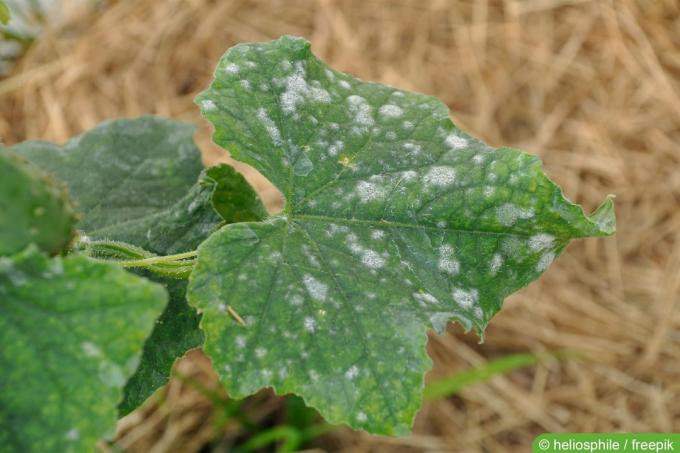
Powdery mildew on cucumbers: how to get rid of it
The powdery mildew often stops by the cucumber bed and quickly conquers the entire plant. That is why every gardener must recognize it early and fight it properly. This is the only way to save the cucumber harvest.

Fighting frizz | 9 home remedies
Peaches from your own garden taste wonderful. More and more hobby gardeners are trying to grow the tasty fruits themselves. The joy is clouded by the appearance of leaf curl in spring. What is this disease? How can you prevent or fight them?
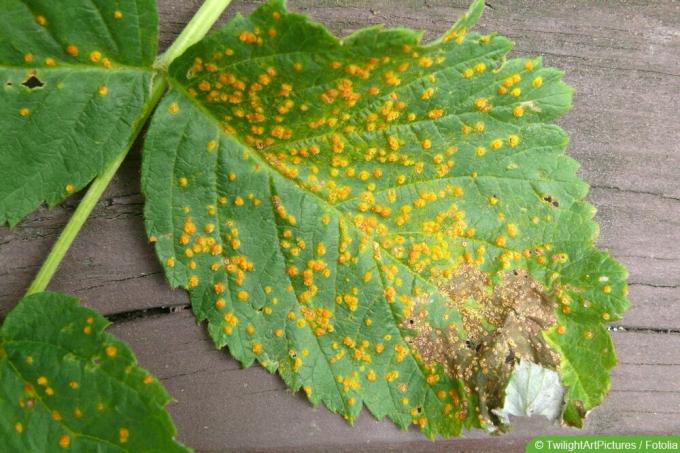
Fighting rust on plants biologically | 5 home remedies
Leaf or plant rust is caused by fungi and can affect ornamental plants as well as crops. Most species of fungi are specialized to a single host or host family and are transmitted by wind. The infestation rate increases significantly with moisture.
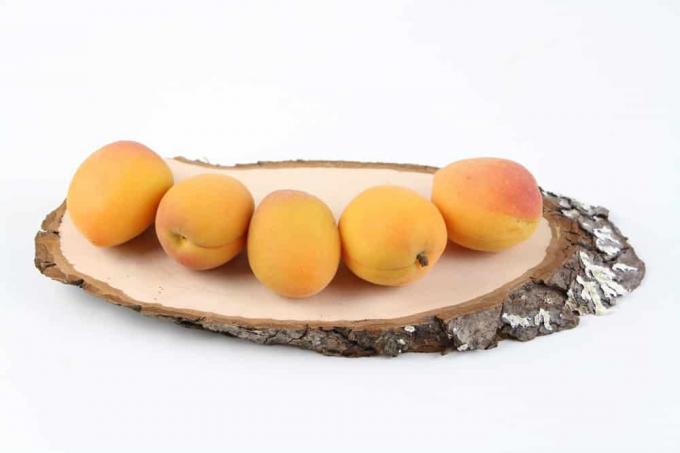
10 typical diseases of the apricot tree and apricot tree
Apricots are one of the most popular fruits in Germany. It becomes difficult to care for an apricot tree in such a way that it is not attacked by a disease. Apricots are known for their susceptibility to diseases and it is therefore important to be able to distinguish between the individual diseases.


